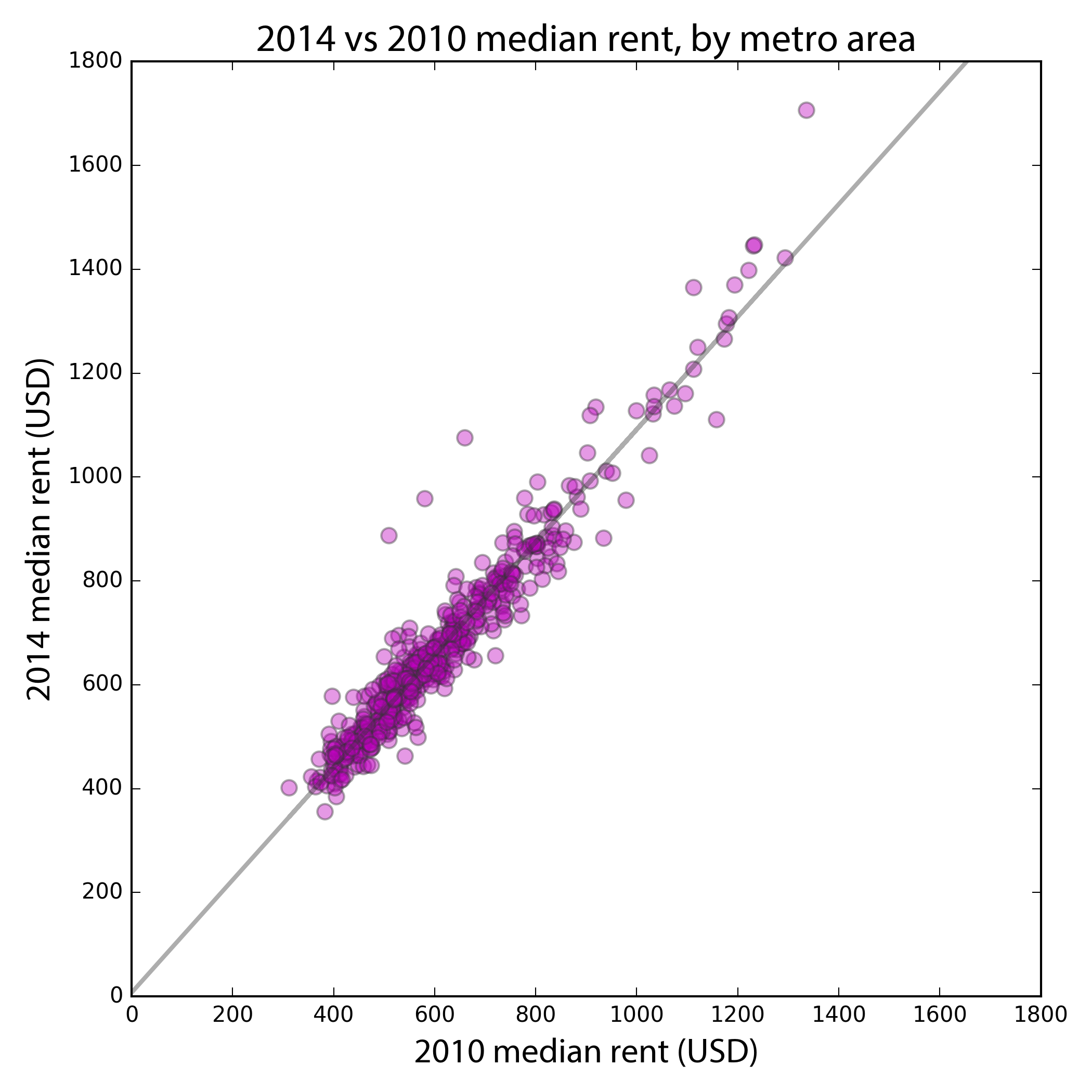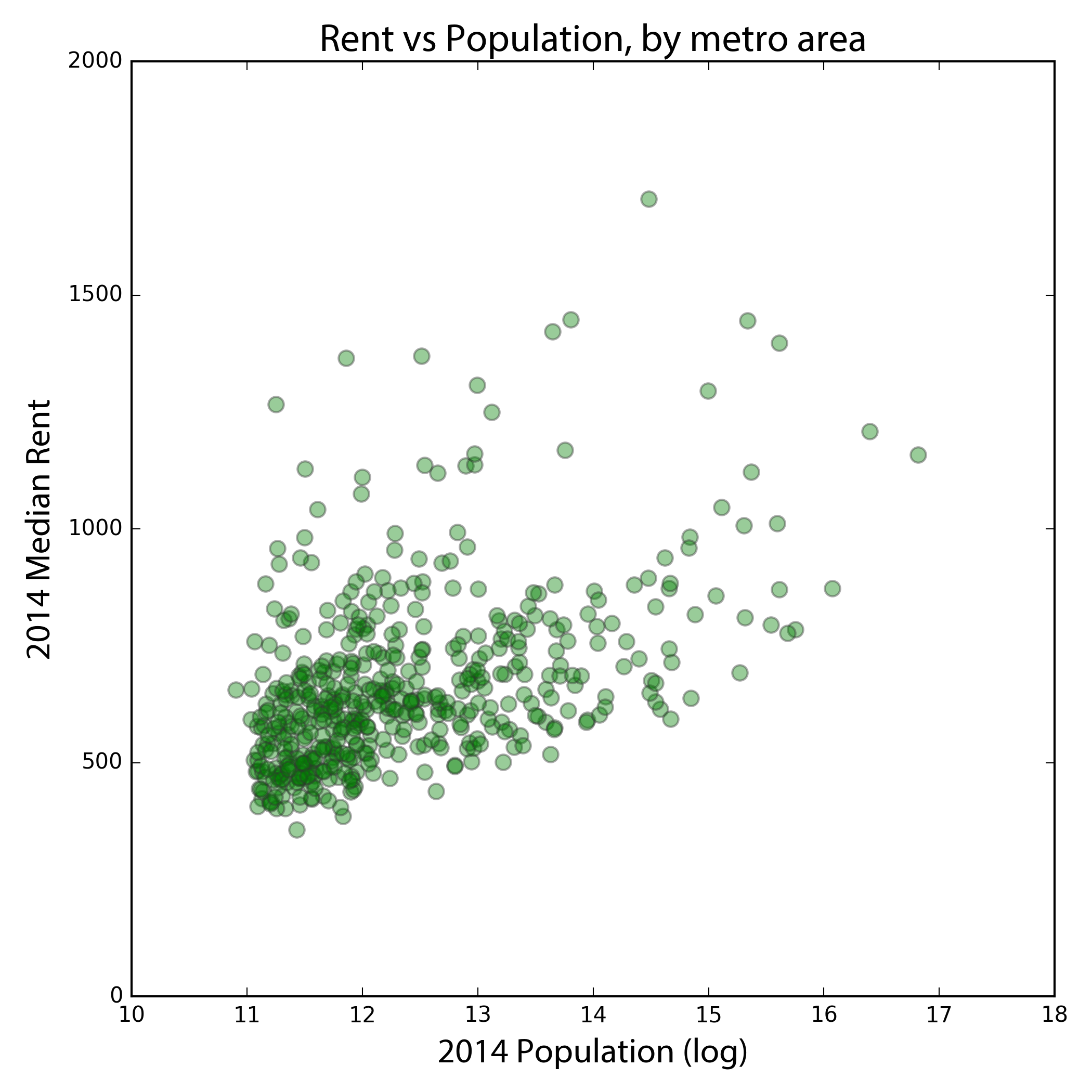Which U.S. cities are the most expensive for rental housing? Where are rents rising the fastest? The American Community Survey (ACS) recently released its latest batch of 1-year data and I analyzed, mapped, and visualized it. My methodology is below, and my code and data are in this GitHub repo.
This interactive map shows median rents across the U.S. for every metro/micropolitan area. Click any one for details on population, rent, and change over time. Click “switch” to re-draw the map to visualize how median rents have risen since 2010:
The expensive coastal cities’ median rents form a red line snaking along the western and eastern seaboards. The nation’s blue interior has lower rents.
But when you switch to the percent change in median rent since 2010, the coasts cool off somewhat and the interior – especially east of the Rockies – warms up. Inland rents seem to be lower than those on the coasts, but also seem to have risen at a quicker rate since 2010.
Cities with the most expensive rents
Here are the U.S. metro areas with the highest rents (listed by principle city), along with the median rent’s percentage change since 2010:
The list of most expensive cities is dominated by California, which comprises 10 of the top 15. Cities around the Bay Area also have particularly large increases in median rent since 2010. New York surprisingly doesn’t even enter the list until #15. By contrast, here are the U.S. metro areas with the fastest rising median rents since 2010:
This list is largely composed of smaller cities, with plenty of representation from Texas and North Dakota – each experienced a major oil boom and housing shortage in 2014. The median rent in Odessa, TX rose 74% between 2010 and 2014, and the rent in Minot, ND rose 65%. Overall, 2014 median rents are closely correlated with 2010 median rents. This scatter plot depicts the 2014 vs 2010 median rents for each metro area, with a simple regression line showing their relationship:
And what about fast growing cities? Do they have faster rising rents? Not really. The next scatter plot depicts the percent change in median rent vs the percent change in population for each metro area: faster growing metros tend to have slightly faster rising rents, but the relationship is very weak.
Faster-growing cities do not necessarily have faster-rising rents. There are clearly other factors at play.
Cities with the cheapest rents
Here are the U.S. metro areas with the least expensive rents, along with the median rent’s percent change since 2010:
The least expensive rents are concentrated in small towns and predominantly in the South. Talladega, Alabama has the lowest rent in the country by a significant margin. Of the 10 cheapest cities, only 2 actually saw their median rents decrease since 2010. Interestingly, North Carolina places 3 cities on this list but also placed 2 cities on the list of fastest growing rents since 2010. By contrast, here are the U.S. metro areas with the fastest falling median rents since 2010:
Talladega pops up here again and the list of cities with the greatest decrease in median rent is peppered with small towns across the US. But if anyone’s looking to move to Kauai, now might be the time with Kapaa’s rent decreasing nearly 6% since 2010!
Rents in the largest cities
The median rents in the 20 most populous U.S. metro areas vary considerably. San Francisco ($1,445) and Washington DC ($1,398) are the highest, while St. Louis ($638) and Detroit ($692) in the Midwest are the lowest (and less than half as high). Interestingly, every single one of the 20 largest metro areas saw rent rise in excess of 5% since 2010 – even struggling areas like Riverside and Detroit.
What is the relationship between city size and median rent? More populous cities generally have higher rents, but the relationship is weak and there could be many latent factors at play. This scatter plot depicts the 2014 median rent vs the (log of) 2014 population of each metro area:
Rents rise and fall for many reasons. Jobs come and go, local economies boom and bust. Fed monetary policy and inflation affect nominal rents. Cities restrict density, which in turn restricts housing supply and pushes up costs. Across this census data, there is no strong relationship between median rent and metro population, or between rent increase and population change since 2010. Larger cities do not always have higher rents, and faster-growing cities do not always have faster-rising rents.
The census reflects the rents that surveyed residents are currently paying per month. This gives an indicator of current metro housing costs, not the current metro market for available units. It’s a representation of housing costs across the area, which comprises rent-controlled units as well as non-rent-controlled units, long-term rentals, recent rentals, etc. But, it’s essential to note that it does not disambiguate the current market for available units.
Methodology
All of the data and code for my maps, analysis, tables, and plots are available on GitHub. The 2014 rent data was just released in September. I downloaded the 2010 and 2014 ACS median contract rent data and annual estimates of population from 2010-2014 from the Census Bureau’s American FactFinder web site.
These data sets cover every U.S. metropolitan and micropolitan area for which the ACS gathers rent data. Some metro area names and IDs changed between 2010 and 2014, in which cases I had to link them to one another. I then parsed out the principle city/state and geocoded it to latitude-longitude for mapping.
I did all the analysis and static mapping in Python with pandas and basemap. I made the interactive map with Leaflet. For more on these methods, check out our Urban Informatics and Visualization course at UC Berkeley or see my GitHub repo for the code.










3 replies on “The Landscape of U.S. Rents”
[…] The Landscape of U.S. Rents […]
The Law of Rent as a domino against opportunity – once coastal rents are jacked as high as possible, rent seekers focus on regional areas. The formula is simple – search Google Earth for property over 800 square metres, near public infrastructure and with zoning overlays already in place. Then use a Property Option to buy it no cash down. Who wants to be a billionaire? Or is it simpler than that Geoff?
[…] pays about $200 a month in loans.) Meanwhile, rents have been rising fast in new years and are particularly high in large cities, where immature people are many expected to […]